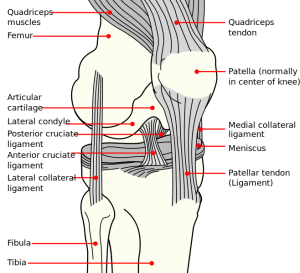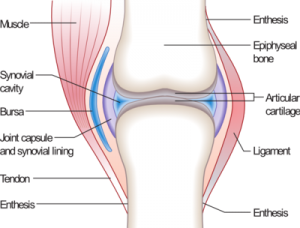MSNBC did a full report the other day on how so many mid-age Americans, the Baby Boomers have started to reach the age where they need to get what are know as “Total Knee Replacement Surgery“. The two stories were…
- “Dr. Mayman answers questions about knee replacement surgery“
- “Brian Williams joins rising numbers of boomers getting new knees“
This type of surgery is required when the person is going through an extremely high level of pain due to the fact that the articular cartilage that is on the distal end of the femur and the proximal end of the tibia are both rubbed away from years of loading and compressing.
In terms of the numbers, from the 2nd article it states, “Over the past decade the rate of knee surgeries has risen dramatically from 378,000 in 2003 to an estimated 704,000 in 2012, according to a government report released in 2012.” It seems that the two main determinants on whether a person will develop bad knees is from genetics and whether old injuries really did heal properly. The increase in the decision to go through with knee replacement surgery seems to be from both an increase in the rate of obsity putting more weight on the body and the increased effectiveness o fthe surgery. The knee replacements are better and can replicate almost exactly the movements of what a natural knee is supposed to be like. The surgeries are also getting less invasive through.
As for the patients, they often wait a little too long to go through with the surgery to remove the pain. It often has to reach the point where the pain becomes unbearable before someone decides to go through with the surgery. What is really interesting was a passage from the article that reminds me of how people feel about going through with surgery to become taller, using the limb lengthening surgery.
‘Look, my knee hurts and it’s interfering with my activities. I’d like you to do what you can: pills, shots, therapy, whatever, so long as it’s not surgery.’
Again, the idea of surgery is something that almost everyone has wanted to put as the last resort. Why are everyone so hesitant and afraid of surgery if it can relieve what could be years of pain? I can state for a fact that often the surgery option is the only option that works, and it is definitely true towards adult height increase and knee pain relief.
Again, the desire to postpone surgery is stated again…
“… She did everything she could to postpone surgery even though her doctors said she needed it to quiet the excruciating pain in her joints.”
The Science Behind Total Knee Replacement Surgery
The thing to realize is that the knee is not actually replaced. It is the cartilage in the synovial cavity that is replaced. It is replaced with metal and plastic. The key idea is to replace the layer of the cartilage to something else so that the bones are not grinding against each other. From Wikipedia…
“…the surgery consists of replacing the diseased or damaged joint surfaces of the knee with metal and plastic components shaped to allow continued motion of the knee”
Common causes of knee pain
- meniscus tears
- cartilage defects
- ligament tears
- osteoarthritis
It states that when people start out in adulthood, there is a total of 3/8 th of an inch of layering of hyaline articular cartilage. This is a combined total of both sides. There is actually 3/16th of an inch of cartilage on the ends of each long bone in the legs. The pain seems to start when there is usually less than 1 millimeter of cartilage left.
The most likely times when pain is noticed is when the knees are put in a situation where they have to be more extensive in the motion.
The replacements are actually very durable, lasting up to 20 years. It is advised by the surgeons to not to do any type of intensive running with the new knees where the replacements can be ruined.
 The Actual Steps Of The Surgery (General Outline)
The Actual Steps Of The Surgery (General Outline)
- The skin over the knee is cut to reveal the tissue underneath
- The vastus medialis which is the muscle of the quads are cut/ detached from the patella bone
- The patella is then pushed to the side
- The distal end of the femur and the proximal end of the tibia are then cut in a very specific way to shape the ends of the long bone.
- The articular cartilage (what is left on the ends of the femur and tibia) on both bones are removed, along with the anterior cruciate ligament. (Sometimes the posterior cruciate ligament is also removed)
- You want to NOT remove the lateral collateral ligaments which connect the tibia to the femur
- You have prefabricated metal parts that are very specific in dimensions and length. That is why you cut the bone ends to very specific guideline numbers.
- You pop on the metal parts on the ends of the precisely cut bone epiphysis.
- Glue the metal parts in place using polymethylmethacrylate (PMMA) cement.
- Some alternative ways of gluing the metal pieces involves making the metal prosthetic porous, allowing for the bone tissue to naturally bind with the metal as the bone grows through the metal piece filling out the holes.
After reading over the articles about it on NBC NEWS, it is interesting to note that many people wrote comments in response to this story to give their own story of how knee pain and cartilage loss has affected their own lives. Many tell their surgery stories.
 From personal experience I am aware that my grandmother herself had to get total knee replacement surgery, and that it has reached the point where she has no cartilage left in the synovial cavity. I was told this to me by my mother who told me that in her knees, it has reached the point where bone is grinding against bone when she moved her legs around.
From personal experience I am aware that my grandmother herself had to get total knee replacement surgery, and that it has reached the point where she has no cartilage left in the synovial cavity. I was told this to me by my mother who told me that in her knees, it has reached the point where bone is grinding against bone when she moved her legs around.
Future Treatment Types That Are In Development
Something that is going to become very attractive is the new biomedical field of electro-spinning aka bioprinting. Bioprinting is using a 3-D Printer to print organic tissue that can be insert into the human body. I wrote about this radical new idea in the post “Increase Height And Grow Taller Through Bioprinting And Electrospinning“. This idea is a technique that many orthopaedic surgeons have considered and is waiting for over the next 2 decades to see whether the fabricated cartilage from the bioprinters will pan out and is strong enough to take the loading of humans.
Ultimately, humans probably don’t like the idea of putting metal parts into their body which will stay in there for the rest of their lives. Imagine the metal detector at all airports going off each time we walk past it.
The study that was published in PubMed entitled “Direct human cartilage repair using three-dimensional bioprinting technology.” shows that the 3D Bioprinting Technology is being developed. Will it arrive in time before we also start to develop pains in our knees? Let’s hope.
The fact is that bioprinted ears already exist, done at Wake Forest University. Since ears are just cartilage themselves, although not as fibrously arranged as say the menisus or hyaline cartilage that are in the knees, it does show that we can already grow cartilage into human parts that will be implanted back into humans.
Conclusion
The main point of this post is to show that even though our research has always been primarily about trying to figure out how to turn bone tissue into cartilage tissue to restart the longitudinal growth of our bones, our research is very applicable for other causes. Not only does our research help people figure out ways to grow taller, this website has also led to insights on how we can….
- Reverse Cavities – there are ways to heal the fractures that are in the dentin
- Completely regrow teeth to be implanted back into the jaw
- Prevent Periodontal Disease
- Treat osteoporosis
- Treat Osteoarthritis, and Rheumatoid Arthritis
- Treat flat foot
- Treat rickets
- Treat bow legs
Almost all research that has ever been done in terms of cartilage regeneration was to help people who suffer from cartilage degeneration from osteoporosis, arthritis, old age, disk compression. In terms of mechanical engineering principles, we can say that the weakest area in the human body in terms of structural integrity would be at the knees.
The knees are so often one of the main causes for pain in older individuals.
The 2nd area of the body that suffers the most injuries would be the lower back, since the tissue that forms the intervertebral discs are just not as strong and durable as human bone tissue. After the lower back, comes the hips and ankles. Note how all of the areas that cause the problems most frequently is not actually bone, but areas between bones.
This website will not just be a place where people will learn about the latest research on what we have done to figure out how to increase height, but also a place where new idea on how to treat multiple orthopedic disorders.

